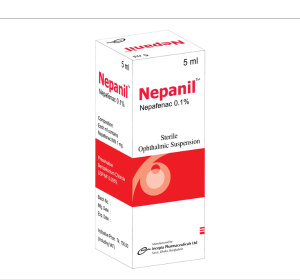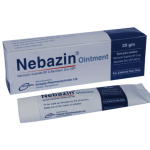Nepanil(Nepafenac 0.1%)

Therapeutic Group: Ophthalmic
Presentation
Nepanil Sterile Ophthalmic Suspension:Each ml contains Nepafenac INN 1 mg.
Description
Nepanil is a sterile ophthalmic suspensions containing Nepafenac – a non steroidal anti-inflammatory drug (NSAID) for topical administration to the eyes. After instillation in the eye, it penetrates the cornea and is converted by ocular tissue hydrolase to Amfenac, a potent nonsteroidal anti-inflammatory drug. Amfenac is thought to inhibit the action of cyclooxygenase enzyme. This enzyme is required for prostaglandin synthesis.
Indications
The treatment of post-operative ocular pain and inflammation including cataract surgery
Inhibition of surgery induced miosis and
Prevention of post-operative cystoid macular edema (CME).
Dosage & Administration
Shake well before use
For post-operative pain & inflammation: Instill 1 drop 3 times daily 1 day prior to cataract surgery and continued on the day of surgery and through the first 2 weeks of the post-operative period.
For surgery induced miosis: Instill 1 drop 3 times daily 1 day before surgery & on the day of surgery.
For prevention of post-operative CME: Instill 1 drop 3 times daily 1 day before surgery and continued on the day of surgery and through the first 6 weeks of the post-operative period.
Side Effects
The most frequently reported ocular adverse reactions following cataract surgery were capsular opacity, decreased visual acuity, foreign body sensation, increased intraocular pressure, and sticky sensation. These reactions occurred in approximately 5 to 10% of patients. Other ocular adverse reactions occurring at an incidence of approximately 1 to 5% included conjunctival edema, corneal edema, dry eye, lid margin crusting, ocular discomfort, ocular hyperemia, ocular pain, ocular pruritus, photophobia, tearing and vitreous detachment. Some of these reactions may be the consequence of the cataract surgical procedure.
Precautions
There is the potential for cross-sensitivity to acetylsalicylic acid, phenylacetic acid derivatives and other nonsteroidal anti-inflammatory agents. Therefore, caution should be used when treating individuals who have previously exhibited sensitivities to these drugs. With some nonsteroidal anti-inflammatory drugs including Nepafenac, there exists the potential for increased bleeding time, so Nepafenac should be used with caution in patients with known bleeding tendencies. Topical nonsteroidal anti-inflammatory drugs (NSAIDs) including Nepafenac, may slow or delay healing. Topical corticosteroids are also known to slow or delay healing. Concomitant use of topical NSAIDs and topical steroids may increase the potential for healing problems. Use of topical NSAIDs may result in keratitis.
Use in Pregnancy & Lactation
Pregnancy: There are no adequate and well-controlled studies in pregnant women. Nepafenac should be used during pregnancy only if the potential benefit justifies the potential risk to the fetus.
Lactation: It is not known whether this drug is excreted in human milk. So, caution should be exercised when Nepafenac ophthalmic suspension is administered to a nursing mother.
Drug Interaction
Specific drug interaction studies have not been conducted with Nepafenac ophthalmic suspension.
Over Dose
No data are available in humans regarding overdosage by accidental or deliberate ingestion.
Storage
Do not store above 30 C. Protect from light. Keep out of the reach of children. Do not use more than 4 weeks after opening.
Commercial Pack
Each plastic dropper bottle contains 5 ml sterile ophthalmic suspension.



